Exercises (2276)
Lateral flexion of the neck in standing, sitting or supine position (left)
Power
Individual work
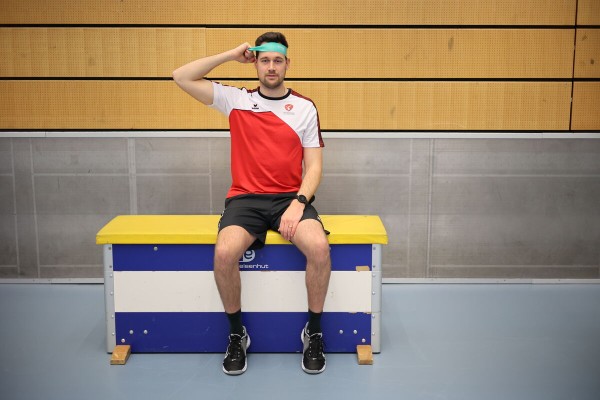
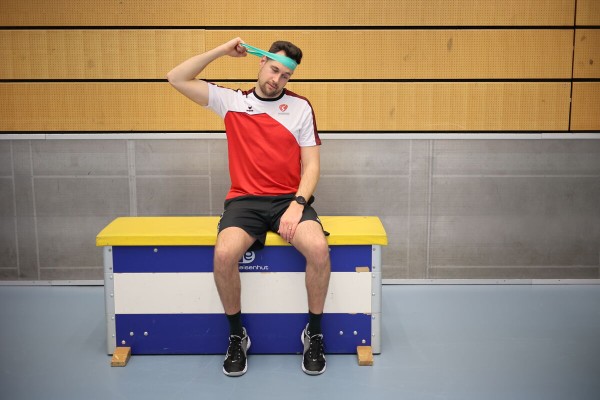
When standing upright, sitting or lying on your back, place an elasticated band around your forehead and hold/fix it with the (right) hand of your bent arm (elbow pointing to the side) to the side of your head at ear level. Tilt the head to the (left) side to stretch/tension the band and return to the neutral starting position (lateral neck flexion).
Attetnion:
Movement takes place exclusively in the neck (upper body and arm remain stable).
Lighten:
Choose a rubber band with less resistance.
Harden:
Choose a rubber band with greater resistance.
1 mini band
1 seating option (e.g. chair, plyo box or vaulting box) ► depending on the starting position
Lateral flexion of the neck in standing, sitting or supine position (right)
Power
Individual work
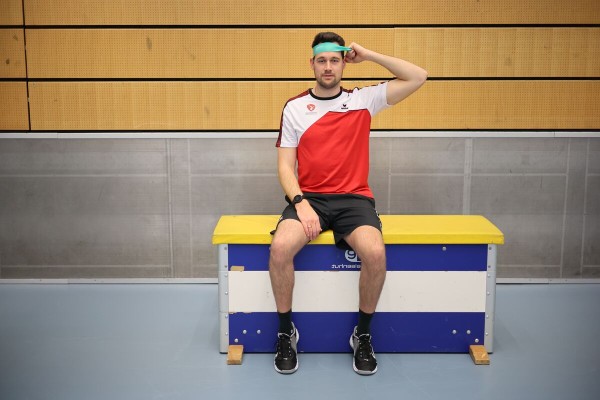
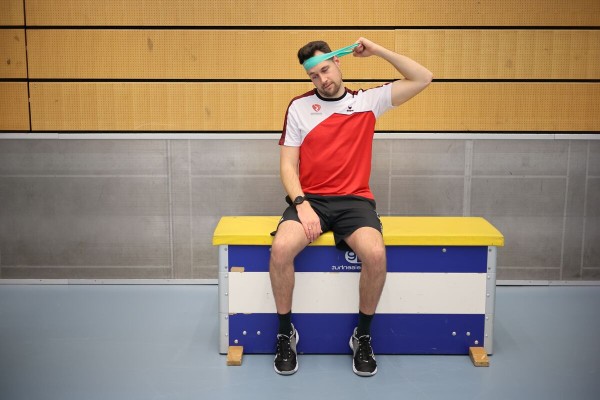
When standing upright, sitting or lying on your back, place an elasticated band around your forehead and hold/fix it with the (left) hand of your bent arm (elbow pointing to the side) to the side of your head at ear level. Tilt the head to the (right) side to stretch/tension the band and return to the neutral starting position (lateral neck flexion).
Attention:
Movement takes place exclusively in the neck (upper body and arm remain stable).
Lighten:
Choose a rubber band with less resistance.
Harden:
Choose a rubber band with greater resistance.
1 mini band
1 seating option (e.g. chair, plyo box or vaulting box) ► depending on the starting position
Flexion and extension of the arms in handstand ► handstand push up
Power
Individual work




Handstand against a wall, facing away from the wall and holding the position by placing your heels against the wall. Bend your arms until your head practically touches the floor (lower your body) and stretch back to the handstand (full body stretch, arms stretched and held high).
Attention:
Lower and raise your upper body in a controlled manner.
Lighten:
barely bend your arms; support the lifting of the upper body with your legs by bending them and pushing them upwards.
Harden:
additional weight (on your feet).
1 wall
2 weight cuffs/1 weight waistcoat ► Make the exercise more difficult (additional weight)
Flexion/retraction of the neck in standing, sitting or supine position
Power
Individual work
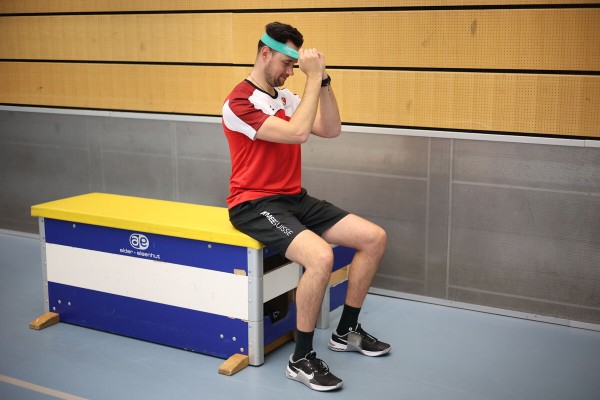
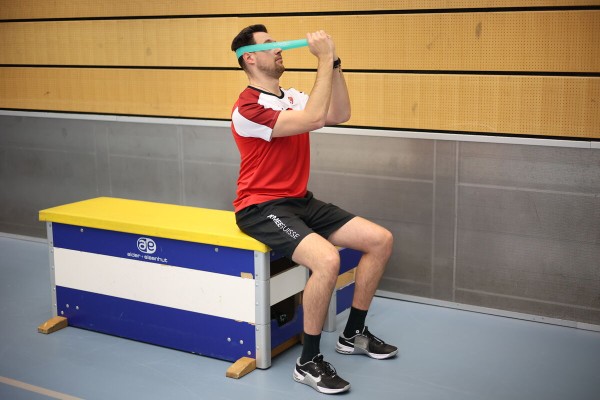
When standing upright, sitting or lying on your back, place an elasticated band around your forehead and hold/fix it with the hands of your bent arms in front of your head (elbows at chest height, hands placed in front of your forehead). Tilt your head slightly forwards and backwards to stretch/tension the band and return to the starting position (neck flexion/retraction).
Attention:
Movement only takes place in the neck (upper body and arms remain stable).
Lighten:
Choose a rubber band with less resistance.
Harden:
Choose a rubber band with greater resistance.
1 mini band
1 seating option (e.g. chair, plyo box or vaulting box) ► depending on the starting position
Flying elbows while standing ► fly
Power
Partner work
1 trainee & 1 helper ► Note change of position
(= double the time required; for lesson planner see Organisation Kraft: Info button Execution)


Trainee: Standing, support the upper body on the vaulting box, clasp your hands behind your head (elbows pointing to the side), bring your elbows together in front of your head (in the direction of your gaze) and back to the starting position.
Partner: Stands on the opposite side of the vaulting box, holds the elbows against the movement of the active participant (pulls upwards/outwards).
Attention:
Always listen to/respond to the partner (adjust pressure/resistance). Elbows are at shoulder height or slightly below.
Lighten:
Less pressure/resistance from your partner.
Harden:
More pressure/resistance from your partner.
1 swing box (3-4 elements incl. top section)
FooBaSKILL
Games / Tournament
Game idea:
Two teams play against each other. On one side of the pitch there are two Swedish boxes, each with a Molankegel or the FooBaSKILL goal on top, which serve as football goals. Football is played on this half. There is a basketball hoop on the other half, where normal basketball is played. In the centre of the hall, the players switch from one sport to the other. In the second half, the roles are swapped. The aim is to score the most points.
Scoring:
Football:
- 1 point: The ball touches the bottom of the Swedish box (wooden structure). The players can aim at 360° of the box.
- 2 pts: The ball touches the bottom of the Swedish box and is stopped (intercepted) by the player of the same team or the kicker himself with the sole of his shoe before it crosses the centre line (second offensive intention in football). Only one point is awarded if a defender intercepts the ball.
- 3 points: The ball brings down the juggernaut or goes through the FooBaSKILL goal.
- 0 points: No point is awarded if the ball touches the top of the box. The game continues without interruption.
Basketball:
- 1 point: The ball bounces off the basketball board without touching the ring and falls to the ground.
- 2 points: The ball bounces off the basketball board without touching the ring and is caught by another team member with both hands before falling to the floor (offensive rebound in basketball).
- 3 points: The ball is kicked into the basket.
- 0 points: No point is awarded if the ball touches the hoop (play continues without interruption) or if the ball touches the back of the basketball board, the edge of the board or the supporting structure (counts as a fault) or if the ball bounces against the basketball board without touching the hoop and is caught by the opposing team with two hands before it touches the floor (play continues without interruption).
Pitch:
22 x 42 metres (with indoor walls)
Number of participants:
4:4 (or 5:5)
Rules of the game:
The kick-off at the start of the game and at the start of the second half takes place in the middle of the pitch with a bounce ball, as in basketball. The ball must be tapped by one of the two players in the centre circle to a teammate. The other players spread out freely across the entire pitch, but outside the circle.
After a point has been scored in football or basketball, the ball is played as quickly as possible. This happens at the point where the ball is seized by the defender. The kick-off takes place immediately with a pass.
The basic rules of classic indoor football and basketball apply.
In the event of an infringement of the rules, play continues with a throw-in at the place where the mistake was made. In the event of a shot at the football goal with the intention of overturning the goal cone or hitting the FooBaSKILL goal, the ball must not exceed the height of these elements. If this happens anyway, it is a fault and the ball goes to the defending team.
Tackling in the FooBaSKILL is prohibited.
It is a fault if:
- The ball touches the hall ceiling or other suspended equipment.
- The ball touches the edge of the basketball board.
- The ball touches the back of the basketball board or the supporting structure.
The walls of the sports hall are part of the playing court. It is permitted to play with the walls in both football and basketball. It is allowed to give yourself a pass against the wall; to give your partner a pass against the wall; to score a goal using the walls.
The duration of the match is twice five minutes. During the first half, one team attacks in football and defends in basketball. In the second half, the roles are reversed.
FooBaSKILL: Dribbling, passing with a basket shot as a finish
Forms of play / exercises
Group work
The participants spread out in the corners of the pitch at the start of the exercise. The sequence of the exercise is as follows:
Two players (A1+B1 or A2+B2) perform the exercise together on one side along the entire length of the hall.
Player A1:
- Dribbling around the marker sticks (incl. change of hands)
- Pass to player B1
- Running around the marker change of hands)
- Pass to player B1
- Run around the marker, demand and receive the pass
- Finish with a lay-up
- Settle into the line of players opposite the starting point (new player B1)
Player B1:
- Sprint to the mark (note timing to player A1)
- Claim and receive the ball
- Pass into the run of player A1
- Chase after player A1 to secure the ball after he has finished (rebound)
- Join the column on the opposite side (new player A2)
Player A2: Analogue to player A1, but becomes player B2 after the exercise
Player B2: Analogue to player B1, but becomes player A1 after the exercise
The players therefore rotate in an anti-clockwise direction.
Pitch:
12 colouring sticks
2 marking cones
x basketballs
FooBaSKILL: Foosball
Forms of play / exercises
2 teams of 4-7 players each
2 teams (4-7 players each) play against each other at their own target. The target is a hoop that is held horizontally in front of the vaulting box by a player standing on the vaulting box. The player may move the hoop towards the ball.
Goal: good teamwork.
Variant:
Target throws to the hoop may not be defended.
Per 2 teams:
1 basketball
2 hoops
x game wristbands / overcoats ►team identification
FooBaSKILL: Passing relay with a basket shot as a finish
Forms of play / exercises
Group work
The participants pass the ball to each other in the specified form before the last player in the line puts the ball in the basket with a lay-up.
Passing sequence:
1. A-B Overhead pass
2. B-C Chest pass
3. C-D Floor pass
4. D-E Lateral curve pass (i.e. pass next to the body; with one or both hands)
5.i.e. pass next to the body; one- or two-handed)
5. E Finish with a lay-up
6. F Secure the ball, then line up with the ball in the column
7. A-F Move to the next position in order immediately after the action
Per group:
5 colouring sticks
x basketballs
FooBaSKILL: Rebound
Forms of play / exercises
2 Teams with 3-4 Spieler
Basketball game with 2 teams (3-4 players each) on one half of the court. Aim for the basket and two additional hoops. An oversized ball, e.g. a gym ball, is placed on the basketball hoop. 2 points can be scored if the basketball bouncing off the gym ball is caught as a rebound. 1 point is scored if the ball is placed in a hoop. This can be prevented by a defender putting his foot in the hoop. The attacker is the referee.
Objectives: Use of the rebound, opening up the game through additional scoring opportunities.
Variant I:
Change of possession after a point or when the ball is lost.
Variant II:
One team tries to score as many points as possible during 1-3 minutes and counts the points.
Per half of the court:
1 basketball
1 basketball hoop
1 gym ball
2 hoops
x game wristbands / covers ► Team labelling
Frisbee Ultimate
Games / Tournament
Game idea:
The team in possession of the frisbee tries to move it towards the targeted end zone. The opposing team tries to prevent this movement and force possession of the frisbee by means of a "turnover" (see rules of the game). The frisbee may only be moved by throwing it from one player to the other.
Scoring:
The aim is to catch the frisbee in the opposite end zone following a pass from a teammate and thus score a point.
Playing field:
Rectangular field with an end zone at each end. 64mx37m with 18m outdoor end zone, 40mx25m with 15m indoor end zone.
The pitch is bounded by cones. The connections between them form the side or out lines.
Number of ends:
7 against 7 outdoor, 5 against 5 indoor
Game rules:
At the start of the game and after each point, the teams line up on their end zone line. The team that starts or has just scored throws a high, long pass towards the opponent's end zone (throw-off). As soon as the disc is released, all participants may move freely on the field. The other team may pick up the disc and start the game.
The disc may be thrown in any direction. The player with the disc in his hands may neither walk nor run, only star steps are allowed. However, if the disc is caught during the race, the movement may be slowed down by the required number of steps. The disc may not be passed, but must move from A to B through the air. If the attackers are unable to catch the disc (disc touches the ground, flies out of bounds or the opponent intercepts it or knocks it to the ground), the defending team gains possession of the disc and attacks. This is referred to as a "turnover". There is no stoppage of play.
The defender covering the thrower must keep at least an arm's length away. Only one player may cover the thrower at a time; the next defender must be at least three metres away. The attacker must play the frisbee after a maximum of 10 seconds. To signal this, the defender counts the seconds out loud.
Body contact or tackling is not permitted. Each player is responsible for signalling an infringement of the rules. There is no referee. Fair play is therefore very important. If an attacker and a defender catch the disc at the same time, it belongs to the attacker.
After a successful point is scored, the teams switch sides. The team that scored the point then starts again with a throw-off towards the opposing team.
Frisbee Ultimate: Burning disc
Forms of play / exercises
2 Teams
In a marked playing field, several markings are made along the outer lines. Two teams play against each other. One team (runner) has the task of completing a predetermined route from mark to mark as quickly as possible. To do this, one participant throws the disc from the drop point (e.g. tyre) and starts running. It is allowed to run until the field team (catcher) returns the disc to the dropping point and burns it there. If the runners are not at the firing point at the same time, they burn and have to return to the start without scoring any points (possibly incorporate additional exercises to shorten the waiting time). Each completed lap scores one point for the runners. If a runner rounds the course without stopping, the run counts double. The field team may not run with the disc, it may only be passed. The winner is the team that scores the most points in a given time (e.g. 2 x 6 minutes).
Variant I:
Only one runner is allowed at each mark. If there are two participants, one burns.
Variant II:
Play with two or more discs.
Pitch:
1 frisbee
x colouring sticks
1 tyre
Frisbee Ultimate: Frisbee handball
Forms of play / exercises
2 Teams
Two teams play against each other on a pitch with a frisbee on two goals. As in handball, the goal circles may not be entered. Unlike handball, however, no physical contact is allowed in this form of the game (one arm's length away from the thrower) and there is no goalkeeper. If the disc falls to the ground, the team that last touched the frisbee loses possession.
Pitch:
1 frisbee
2 goals (handball/uni hockey goals or mats)
x cones (goal circles)
Frisbee baseball (Brennball)
Forms of play / exercises
Group work
2 teams
Two teams play against each other, with one group representing the throwing team and the other the catching team. The roles are swapped halfway through the game (define the number of throws or set a time). Two marker cones mark the throwing zone, behind which all players of team A line up. Four further marker cones (placed in a rectangle) symbolise the running track. Team B lines up along the entire running track within the playing field.
Two runners from team A get ready to throw. One player holds the rugby ball, the other the throwing disc. At the same time, they throw the ball into the pitch. After each throw, both participants run to the first marker cone on the running track. The players of team B try to get the throwing disc to the "burning point" (hoop) as quickly as possible. The second task of the field team is to line up in a column and pass the ball between their legs to the last player. The last player in the line is usually the player who placed the disc in the hoop. So if the disc is in the hoop, all field players have touched the ball and passed it between their legs to a team-mate, the entire team B shouts "Stop" as soon as the last player in the one-man column has received the ball. If the runners are not at a marker but on the track when the "stop" signal is given, they must return to the previous marker (any number of runners may be at the markers). The runners therefore decide for themselves at each marker whether they want to continue their run or wait (until the next throw of the other players to continue the run). The team receives one point for each completed run. The points are entered on the score sheet by the respective participant after the run (put a line behind the team name). If the ball or throwing disc is caught directly by the field team, the field team receives one point, which is noted on the score sheet by the sports director. Whichever team scores more points with the number of defined throws or within the specified time wins the game. The number of throws is the slightly fairer option to prevent the field team from suddenly starting to run out of time when the equipment is returned.
Variant:
If a runner is not at a marker when the "stop signal" is given, they must return to the start and line up with the throwers (or drop out completely and perform additional tasks at the edge of the field).
6 marking cones
1 rugby ball
1 throwing disc (frisbee)
1 tyre
1 flipchart (evaluation)
Frisbee Olympics
Orienteering
Single run
Frisbee-OL is a fun form of endurance training, as running is combined with Frisbee target throws and running to various posts.
The Frisbee is thrown at numbered tyres (Velopneus). If the tyre (Velopneu) is hit (contact is sufficient), the corresponding control can be approached and stamped on the run card. So that not all participants start with the same target or run to the same control, the first target can be marked on the run card, which must be hit first. After that, the targets can be chosen freely. One throw is available for the shorter distances up to the centre line, and two throws from the centre line onwards. If the attempts are unsuccessful, a penalty lap must be run around the marked field before the targets can be thrown at again. The Frisbee must be returned to the baseline before the control or the penalty lap is tackled. Each participant who moves within the marked field must ensure that they are not hit by a frisbee. Who will be the first to reach all the posts or the most posts in a certain time?
There are various ways to distribute the posts:
- The posts are distributed within sight of the throwing field so that the participants can easily reach them (e.g. place numbered F-discs with a clamp on a grass field).
- If the controls are out of sight of the throwing field, the participants are given a map/sketch of the controls (can be integrated on the map) in addition to a running map, which they can use to run to the controls.
- A poster with the controls marked on it is attached to the throwing field. The participants memorise the route to the respective post (memory run).
14-20 tyres/cycling tyres
14-20 orienteering posts (fixed, but controlled or for unplugging)/F-discs incl. Mini pole with pliers
6 fanjons/marking cones/caps/painting sticks
1 route tape
x throwing discs (frisbees)
1 stopwatch
1 poster with control overview (memory run)
Participant:
1 running map form 30.063
1 orienteering map; if control not in sight (prepared in advance by sports director)
Frontal and lateral raising and lowering of the arms while standing ► front raise/lateral raise (side raise)
Power
Individual work

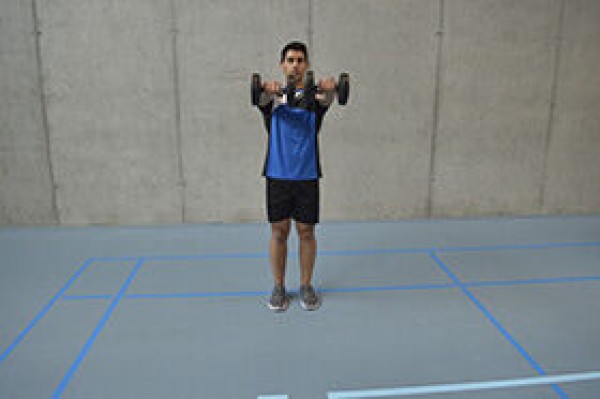

Stand upright, arms extended downwards in front of your body with the dumbbells in your hands (hanging), the backs of your hands pointing forwards (overhand grip), raise your arms in the direction you are facing until they are horizontal (shoulder height, backs of hands pointing upwards), spread your arms out to the side from the holding position ("T" position), bring your arms back together in front of your head and lower them back to the starting position.
Attention:
Keep your back straight (possibly back against a wall), actively tense your core.
Lighten:
Less weight.
Harden:
More weight.
2 dumbbells
Frontal and lateral raising and lowering of the arms in prone position ► front raise/lateral raise (side raise)
Power
Individual work







Stomach position on the inclined flat bench, arms almost stretched out towards the floor (hanging), grasp a dumbbell with each hand (overhand grip, palms facing forwards). In one movement, raise your arms frontally to approximately chin height (palms facing down), spread your arms out to the side (T-position, arms parallel to the floor), then bring your arms to the floor (palms facing your body). Now perform the movement in reverse order: Raise your arms sideways, bring them together in front of your head, then lower your arms to the floor back to the starting position.
Attention:
Despite the reduced possibility of falsification due to the upper body being fixed on the incline bench, ensure that the movement is performed slowly and evenly (jerking the weights upwards always leads to poorer training results and increases the risk of injury).
Lighten:
Less weight.
Harden:
More weight.
1 flat bench
2 dumbbells
Football
Games / Tournament
Game idea:
Two teams with several outfield players and a goalkeeper each shoot the ball into the opponent's goal by attacking skilfully. Good defensive behaviour should prevent the opponent from scoring goals.
Scoring:
A goal is scored when the ball crosses the opponent's goal line in its entirety.
Playing field:
120 x 90m (maximum), or 90 x 45m (minimum).
The pitch size can be adjusted for sports lessons.
Number of participants:
11:11 (incl. one goalkeeper per team).
Adjust the number of players if the pitch size is changed.
Playing rules:
The game is opened at the start of each period by a kick-off by one team in the centre of the pitch. The same applies after a goal has been scored, whereby the team that has conceded a goal has the right to kick-off. The ball may be played with any part of the body except the arms. Within the penalty area (rectangular area with a width of 16.50 metres from the respective post and the same depth), the goalkeeper may take the ball in his hands. Handball and fouls (holding, clutching, punching, pushing, putting the leg down, kicking the legs, leaning, etc.) outside the penalty area are penalised with a direct free kick for the opposing team (i.e. possession of the ball at a distance of 9m from the opponent). If the offence takes place inside the penalty area, the opposing team is awarded a penalty from a distance of 11m from the goal.
If a player kicks the ball out of bounds over a touchline, the opposing team is awarded a throw-in, whereby the ball is thrown back into the field to a team-mate with a two-handed throw over the head from outside the touchline. If the ball leaves the field of play over the outer goal line, a goal kick (last touch of the ball by the attacker) or a corner kick (last touch of the ball by the defender) is awarded, depending on who last touched the ball.
Football/Futsal: Carousel
Forms of play / exercises
Group work
Simple standard pass and shot exercise: The players stand in both corners next to the goal. The foremost player runs in a high arc into the centre in front of the goal (around the marker stick). There he receives the ball from the other side and shoots (at the height of the two cones). The passer runs up next and shoots at the goal.
Variations:
Shooting at the empty goal or whoever has shot then stands in the goal themselves.
The sports leader can request different types of passes/shots (direct shots are also possible).
Per group:
1 goal
x footballs
4 cones (incl. starting markers)
1 colouring stick
Football/Futsal: Pass
Forms of play / exercises
Groups of 2
Two participants face each other and pass the football to each other. The distances, types of pass and ball reception are varied (instep, outstep, full instep, direct play, etc.). After the static form, the participants move freely around the hall/grounds and pass the ball to each other while moving.
Per group:
1 football
Football/Futsal: Passing in the group
Forms of play / exercises
Group work
All participants move freely around the hall/grounds. Within the group, the participants pass a football to each other. The exercise is then reorganised so that one group (e.g. blue) passes the ball to the other group (e.g. red) and in turn receives the ball from another group (e.g. green). The sports leader can integrate additional balls into the exercise.
Per group:
1 football
4 additional balls
x wristbands / overcoats ►team identification
Football/Futsal: Goalball
Forms of play / exercises
2 Teams
Two teams play against each other on a limited playing field. The team with the football tries to pass the ball between the goals (e.g. colouring sticks, cones or marker cones) as often as possible. The ball must be caught/received by a team-mate behind the goal. If the opposing team captures the ball, they can try to score goals.
Pitch:
8 goals
1 football
16 colouring sticks
16 cones
16 marker cones
x game ribbons / covers
Footsteps
Fighting and roughhousing games
Partner work

Two participants stand opposite each other and grab each other by the shoulders. The participants try to step on their opponent's feet. Who collects more kicks?
No material required
Futsal
Games / Tournament
Game idea:
Two teams with several outfield players and a goalkeeper each shoot the ball into the opponent's goal by attacking skilfully. Good defensive behaviour should prevent the opponent from scoring goals.
Scoring:
A goal is scored when the ball crosses the opponent's goal line in its entirety.
In the hall, long benches can also be used as goals. On the one hand, the bench can be turned over and the ball must be played between the seat and the support surface, or on the other hand, the bench can be tilted and a goal is scored when the ball is played against the seat surface.
Playing field:
22 x 42 metres (e.g. handball field or hall wall).
Number of participants:
5:5 (incl. one goalkeeper per team)
Game rules:
The game is opened at the start of each period by a face-off by one team in the centre of the field. The same applies after a goal has been scored, whereby the team that has conceded a goal has the right to kick-off. The ball may be played with any part of the body except the arms. Inside the penalty area, the goalkeeper may take the ball in his hands.
Any physical contact is considered a foul. Tackling - regardless of whether the ball is played or not - is also prohibited and results in a free kick for the opposing team. After a predetermined number of fouls (adapted to the length of the game), the opposing team is awarded a penalty for each additional foul.
Variation:
A penalty is awarded after three fouls, after which the number of fouls is reset to zero.
If a player kicks the ball out of bounds over a touchline, the opposing team gains possession of the ball. The ball is put back into play with a "kick-in" (no direct shots on goal allowed)
Memory run
Orienteering
Single run or 2/3 groups
In the terrain, the sports director distributes posts in advance, which the participants then run to individually or in small groups during the memory run. For this purpose, a poster (or several posters - depending on the number of participants) with all the posts marked on it is put up at the start. The participants memorise a route and try to collect the posts. Depending on how many posts the participants can memorise, they have to return to the starting position sooner or later to take another look at the map. The memory run is more suitable as a form of exercise than a competition. The map is distributed to the runners/groups before the start. For the memory run, each participant/group has a defined amount of time to find as many or all of the posts as possible.
OL posts (to be unplugged)
2-3 posters with post overview
1 (stop) clock
Participant/group:
1 running map form 30.063
1 bussole